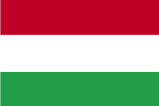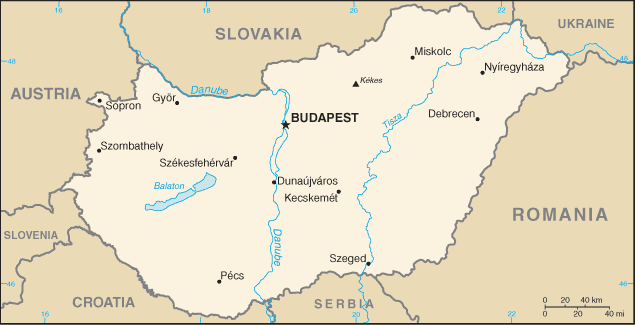|
Hungary
|

|
Capital: Budapest
Population: 9,684,679
Brief History of Hungary:
The land that is Hungary today was originally inhabited by a number of peoples and empires. For a time it was part of the Roman empire as well. In 895 the Magyars came to the land. These people would later be called the Hungarians. By 1000 AD the Kingdom of Hungary was born. It was a Christian Kingdom and ruled for many centuries fighting off the Ottoman Empire from expanding into Europe. Later the kingdom would become part of the Austria-Hungarian Empire.
After losing World War I, the empire had collapsed and Hungary shrunk significantly. Then in WWII, Hungary first sided with Germany and then tried to switch sides later. After the end of WWII, Hungary became a communist country and under the power of the Soviet Union. When the Soviet Union fell in 1990 Hungary had its first free elections and started a free market economy. In 2004 it became a part of the European Union.
The Geography of Hungary
Total Size: 93,030 square km
Size Comparison: slightly smaller than Indiana
Geographical Coordinates: 47 00 N, 20 00 E
World Region or Continent: Europe
General Terrain: mostly flat to rolling plains; hills and low mountains on the Slovakian border
Geographical Low Point: Tisza River 78 m
Geographical High Point: Kekes 1,014 m
Climate: temperate; cold, cloudy, humid winters; warm summers
Major cities: BUDAPEST (capital) 1.705 million (2009), Debrecen
The People of Hungary
Type of Government: parliamentary democracy
Languages Spoken: Hungarian 93.6%, other or unspecified 6.4% (2001 census)
Independence: 1001 (unification by King Stephen I)
National Holiday: Saint Stephen's Day, 20 August
Nationality: Hungarian(s)
Religions: Roman Catholic 51.9%, Calvinist 15.9%, Lutheran 3%, Greek Catholic 2.6%, other Christian 1%, other or unspecified 11.1%, unaffiliated 14.5% (2001 census)
National Symbol: Holy Crown of Hungary (Crown of Saint Stephen); turul (falcon)
National Anthem or Song: Himnusz (Hymn)
Economy of Hungary
Major Industries: mining, metallurgy, construction materials, processed foods, textiles, chemicals (especially pharmaceuticals), motor vehicles
Agricultural Products: wheat, corn, sunflower seed, potatoes, sugar beets; pigs, cattle, poultry, dairy products
Natural Resources: bauxite, coal, natural gas, fertile soils, arable land
Major Exports: machinery and equipment 61.1%, other manufactures 28.7%, food products 6.5%, raw materials 2%, fuels and electricity 1.6% (2003)
Major Imports: machinery and equipment 51.6%, other manufactures 35.7%, fuels and electricity 7.7%, food products 3.1%, raw materials 2.0% (2003)
Currency: forint (HUF)
National GDP: $195,600,000,000
** Source for population (2012 est.) and GDP (2011 est.) is CIA World Factbook.
Back to Geography Home Page
